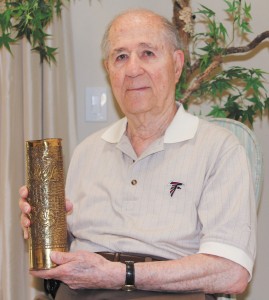
When Hilbert Margol received a letter inviting him to Poland, he wasn’t sure what to make of it.
The letter asked to him to respond with more information about his time in the U.S. Army, and offered to pay all of his expenses if he could make a journey to Eastern Europe this April.
“I got this letter out of the blue. I had never heard of these people,” said Margol, a resident of the Lakeview Oaks subdivision in Dunwoody.
But Margol decided to give it a shot. He replied and learned that he had been contacted by an organization called March of the Living because of his role in history. Margol was a member of the U.S. Army’s 42nd Division, which liberated the Dachau concentration camp near Munich, Germany in 1945.
This year, March of the Living is celebrating its 25th anniversary by bringing together Holocaust survivors and those who liberated concentration camps to take part in the program.
Hilbert and his wife will fly from New York to Poland to take part in March of the Living, a program that takes participants on a march from Auschwitz to Birkenau, the largest concentration camp complex built during World War II, according to the organization.
The march takes place on April 19, known as Yom Hashoah, the Israeli Holocaust Remembrance Day.
Margol plans to bring a bit of home with him on his journey. The city of Dunwoody recently issued a proclamation recognizing Holocaust Remembrance Day. Margol asked for a copy of the proclamation, which he will frame and bring with him to be included into the program.
Margol, still lively and engaging at 88, remembers his years of military service well.
His unit had moved into Germany and was on the way to fight in Munich when Margol said one of the jeep drivers noticed a large compound in the village of Dachau, about 10 miles outside of Munich. They didn’t know what it was, but Margol said the driver guessed it might be a chemical plant due to the strange odor in the air.
Margol said his brother associated the smell with their childhood, recalling the smell in the house when their mother would bring home a freshly killed chicken from the meat market and hold it over a gas burner to singe the remaining bits of feathers from the skin.
Margol later would learn that Dachau was one of the Nazis’ largest concentration camps, housing about 30,000 prisoners. “We knew absolutely nothing about such camps,” Margol said.
Though they had orders to be in Munich, they took a short detour to the Dachau concentration camp on the morning of April 29, 1945.
“The first thing we saw was railroad boxcars outside the main gate,” Margol said. Inside the cars, “the dead bodies were stacked like cordwood.”
Margol said the sight was initially shocking, but he still didn’t know what it meant. He had been at war for months, he said, and seen many dead bodies. They only stayed at the camp for a few minutes before getting back on the road to Munich.
“At the time, we knew we had to get back to our gun positions,” Margol said. “Leaving your post in a combat zone was punishable by death.”
The official surrender of the camp took place that afternoon, Margol said.
“For years we never knew anything,” Margol said. “We didn’t understand. We didn’t know.”
Years later, he would go into business with his brothers selling home goods door to door. When they started selling watches, they hired a master watchmaker as a repairman. He was a Holocaust survivor who had been in Dachau.
“I purposefully refrained, my brother and I both … from asking questions about his experience in Dachau,” Margol said.
Eventually, he opened up and told them some of what he experienced.
“Sam one day told us about how the SS officers and some pilots would bring watches and clocks to him to repair,” Margol said. “Any number of times … they would put a gun to his head and say if it lost one second, they were coming back to pull the trigger.”
Margol has read a lot about the war and the various accounts of Holocaust survivors and concentration camp liberators over the years, he said.
“All the tremendous stories written and movies made … about people’s experiences during the Nazi regime period, I have to feel there’s at least that many more that have not been written, not been made into movies.”
